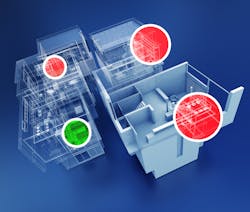The Internet of Things (IoT) is huge, and it won’t slow down any time soon. The technological movement of smart “everything” continues to expand and now even includes speculation about what future urban planning and management will be like. This “Building” Internet of Things (BIoT) is an enormous prospective market trend. When considering where to invest or how your company will maintain relevance in an increasingly digitized world, consider the BIoT.
In its report, “The Internet of Things in Smart Buildings 2014 to 2020,” Memoori projected the BIoT market would grow from $22.93 billion in 2014 to more than $85 billion in 2020. This growth would be related to the sectors of Physical Security, Lighting Control, and Fire Detection & Safety. A recent study conducted by researchers at Intel projected more than 50 billion devices would be cloud-based by 2020. The technology giant is convinced the BIoT will be a huge opportunity for business growth and already created a line of cloud-capable processors to capitalize on the upcoming market trend.
Why BIoT?
While the BIoT will make life easier for everyday consumers, the huge push for BIoT is largely in efforts to benefit building managers and owners. The largest expenses for business owners are real estate, including rent or mortgage, taxes, and energy consumption. But what if you could manage your energy consumption from anywhere in the world using your mobile phone? What if you could view your security cameras remotely via mobile device? Welcome to the BIoT.
On a grand scale, the Building Internet of Things will allow building engineers to better manage their properties. From monitoring the number of people in every room and temperatures of individual offices to controlling each light switch remotely, BIoT technology will help make life easier. There will be no more walking around a 100-story building to turn off light switches or tinkering with thermostats—and this is just the simplest form of BIoT. If you have a mobile device, you’ll have the power to change anything from anywhere.
It’s All Stored on the Cloud
Some upcoming technologies will significantly increase energy efficiencies in corporate spaces. One technology under development assesses the temperature of small spaces and individuals within those spaces to determine if the thermostat needs to be adjusted. If a room isn’t in use after 2 p.m., but a room next door is occupied until 6 p.m. daily, the technology will monitor the temperatures of that room automatically. Another idea recently proposed includes blowing cold or warm air directly at room occupants. Why cool an entire room if only the room occupants need cooling? This will significantly decrease the amount of energy consumption used by corporate buildings, urban spaces, and the world at large.
While the BIoT has huge implications for decreasing the global carbon footprint, it may also revolutionize the way we collect data. Generating datasets for security, home automation, energy consumption, and more will be easier than ever before, because everything will be available on the cloud. If energy consumption statistics for an entire city are needed, for example, that information can be generated through automated data collection technologies embedded in HVAC cloud services. Similarly, if a local police department needs information regarding a crime, video feed can be accessed and analyzed online from anywhere in the world (assuming it has permission to view the footage). The future world will be more interconnected than ever before. Although this can be scary because of security concerns, it’s also liberating and allows people to optimize their time and complete tasks faster.
What About Security?
A major concern regarding the IoT is security, and for good reason. A study conducted by HP found that each IoT device studied expressed security vulnerabilities of varying degrees. A more recent study found that small, wearable IoT devices, such as the FitBit, may send user information to various networks without discretion. In another study conducted by HP, IoT-connected home security units featured security vulnerabilities, too. The research team discovered that hacking into video feed was easy. The very system designed to keep your family safe could be a liability instead of an asset.
The fact is many IoT technology manufacturers don’t put safety first. Demand for smart products is greater than technological capability to make those products secure. Does this mean we should refrain from IoT connectivity? Of course not. But it does mean that consumers need to put more pressure on manufacturers to ensure their Cloud servers are secure, even if it means waiting a little longer for production.
Overall, the BIoT will offer amazing benefits for consumers and business owners alike. Everyone is busy. Being able to do thing like manage thermostats and home security units while mobile allows everyone to spend more of their time doing what they enjoy. That’s what technology is all about–making life just a little easier.
About the Author
Cabe Atwell
Technology Editor, Electronic Design
Cabe is a Technology Editor for Electronic Design.
Engineer, Machinist, Maker, Writer. A graduate Electrical Engineer actively plying his expertise in the industry and at his company, Gunhead. When not designing/building, he creates a steady torrent of projects and content in the media world. Many of his projects and articles are online at element14 & SolidSmack, industry-focused work at EETimes & EDN, and offbeat articles at Make Magazine. Currently, you can find him hosting webinars and contributing to Electronic Design and Machine Design.
Cabe is an electrical engineer, design consultant and author with 25 years’ experience. His most recent book is “Essential 555 IC: Design, Configure, and Create Clever Circuits”
Cabe writes the Engineering on Friday blog on Electronic Design.

